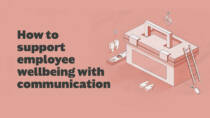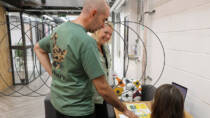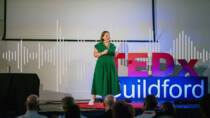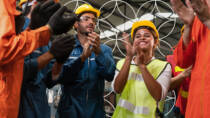Change isn’t a Gantt chart – it’s human
By Sally Pritchett
CEO
Rethinking how we lead and communicate through transformation.
Ask a room full of professionals what comes to mind when they hear the word “change” and you’ll get a mix of answers. In a recent Work Wonders webinar, responses ranged from exciting and energising to exhausting and overwhelming.
We know that change isn’t neat or easy. It’s messy, emotional – and the way we respond to it is deeply human. As talent leader Alistair Antoine said during the session: “Change is not a Gantt chart.” Yet too often, that’s how organisations treat change programmes – as a timeline to manage, rather than a process people go through.
Change doesn’t work if it’s done to people, not with them
One of the biggest reasons transformation projects stall is because leaders try to enact change on employees, instead of working with them. Whether it’s a restructure, new leadership or a shift in strategy, people need to be part of the process – not just passive recipients of announcements and comms.
To get real engagement and buy-in, you need to create space for better conversations. That means giving people room to ask questions, share concerns and make sense of what’s changing in a way that feels respectful and supportive. When people feel heard and involved, they’re far more likely to move with the change than against it.
Trust is built – or lost – during change
The stakes are high. The Times recently reported that 38% of leaders would rather resign than lead another change programme. That speaks to the pressure and fatigue many are feeling – but it also highlights how vital trust and belief are during change.
People look to leaders for clarity and reassurance – but also for honesty. Communicating with openness, listening without defensiveness, and showing care are powerful signals. And they’re often what separates successful transformations from the ones that fizzle out.
As coach and change expert Kate Oates reminded us in the session, people need time to process. Change is a transition, not a switch to be flipped. And it’s much harder to lead through that transition if you’re rushing the emotional impact or pretending its business as usual.
Culture, safety and storytelling all matter
Communication in change can’t just be top-down messages or weekly updates. You need to build psychological safety first by making space for feedback, choosing language that’s honest and human, and shaping stories that people can connect to – stories that make sense of what’s ending and offer a clear picture of what’s next.
Change might start with a business need, but it’s sustained through your people. That’s why the most effective transformations embed culture, values and communication into every stage – from early conversations to everyday moments.
Missed the session?
Check out the highlights video below, featuring some of the most powerful takeaways from the discussion with Sally, Alistair and Kate. If you’re thinking about how you communicate change in your organisation – and want to lead with more humanity, not just process – it’s worth a watch.
Want to be part of the next conversation?
Work Wonders is our growing community for people who care about improving workplace culture, communication and inclusion. If you’d like to join future webinars, access practical tools and connect with others driving meaningful change – join us here.
Watch the highlights: Rethinking Change and Communication
<
Three common leadership mistakes that derail culture transformation
By Sally Pritchett
CEO
These three leadership missteps are behind many stalled culture transformations – and they’re all avoidable.
Culture change isn’t something you can just tick off the to-do list. When done well, it creates a lasting shift that shapes how people think, act and work together. Yet too often, leaders unintentionally undermine the transformation they’re trying to lead.
Here are three common culture change mistakes – and how to avoid them:
1. Treating it like a one-off campaign
Culture isn’t a project with a start and finish date. It’s everyday actions, decisions, conversations, the way people treat one another. When leaders approach culture transformation as a time-limited initiative, complete with launch events, posters and slogans, momentum fades fast. People revert to old habits, and the “new culture” becomes a past-tense idea.
How to avoid it:
See culture change as a long-term commitment. Build it into business as usual. Keep reinforcing the vision in team meetings, performance reviews, recognition schemes and even day-to-day conversations. Leaders need to model the change every single day.
2. Forgetting to listen
It’s easy to design a culture from the top down. But when employees aren’t asked for their input – or worse, are asked and then ignored – they’ll see the transformation as “management’s thing.” This is one of the most common culture transformation errors, and it quickly breaks down trust.
How to avoid it:
Create genuine two-way dialogue. Use surveys, focus groups and informal conversations to understand what’s working and what’s not. Act on the feedback you receive and make it clear how employees’ voices are shaping the transformation journey. When people feel heard, they’re more likely to engage and drive forward the long-term culture you’re trying to achieve.
3. Neglecting cross-functional ownership
Culture touches every part of the organisation – from hiring to customer service to finance. Yet many culture change efforts stay siloed within HR or internal comms. Without shared responsibility across functions, change is unlikely to gain traction.
How to avoid it:
Treat culture like any other strategic priority. Involve leaders from all departments in defining, embedding and sustaining it. Give managers the tools and confidence to bring culture change to life in their teams. Because when every function feels responsible, culture is likely to change quicker and become a part of the everyday.
Culture transformation success isn’t about one big moment. It’s about hundreds (or likely even thousands) of consistent actions, owned by everyone and guided by leaders who listen and inspire others. Avoiding these mistakes means you’re not just running a campaign – you’re creating a movement.
Find out what’s really driving (or blocking) your culture
If you want to avoid these common culture transformation mistakes, the first step is knowing where your gaps are. That’s exactly what our THRIVE diagnostics are designed to do.
We’ve created six quick tools – one for each of our THRIVE pillars – that give you tailored insight into what’s working well and where there’s room to improve. Each one takes just a couple of minutes and comes with practical next steps you can act on straight away:
Take one, a few, or all six – and you’ll walk away with clear, practical actions to strengthen your culture.
When employees feel clear, connected and supported, culture transformation doesn’t fade out – it sticks. And if your results highlight areas to focus on, we’re here to help you take the next step.
Guide: How to support employee wellbeing with communication
By Sally Pritchett
CEO
Your shortcut to considered communication that supports employee wellbeing.
Whether it’s burnout, financial strain, chronic illness or mental health, the way we talk about wellbeing with employees makes a difference. The words we choose and the tone we set can either build trust – or come across as performative rather than supportive.
This guide is here to help. It offers practical advice for bringing a wellbeing lens to your communication so your messages feel thoughtful and rooted in care.
What’s inside:
-
Why poor communication can undermine wellbeing – even with good intentions
-
How to avoid overpromising, assumptions and unhelpful tone
-
Tips for writing with clarity, empathy and inclusivity
-
Language swaps that reduce stigma and help people feel seen
-
Advice for managers having sensitive conversations
-
Real-world examples to learn from
Who it’s for:
This guide is for anyone working in internal comms, HR, DEI or wellbeing – especially if you’re looking to strengthen your messaging, embed wellbeing into the everyday.
Download here: How to support employee wellbeing with communication
Download your screen reader–friendly guide below. Need help? Get in touch: hello@somethingbig.co.uk
PDF version
A PDF that can be read by a screen reader
8 things you probably didn’t know we do (some may surprise you)
By Sally Pritchett
CEO
We do more than strategic campaigns – here are eight ways we add unexpected value.
Our expertise is wide, and it often surprises people how much we do beyond delivering effective and inclusive creative communications. Here are eight areas where we add value in different, and sometimes unexpected, ways:
1. Naming
We create names with strategic clarity and long-term value. From naming strategies to creative options, we ensure names are credible, ownable and compelling. Whether it’s a new product, service or transformation project, names might seem like small details – but they play a big role in positioning and impact.
2. SharePoint
When employees can’t find what they need, productivity takes a hit. We design better SharePoint user experiences, making navigation clearer and information easier to access.
3. eLearning
We design and build eLearning modules, and output SCORM files, so you can bring more creativity to your team learning.
4. Gamification
From quizzes and competitions to interactive tools, we create gamified content that both informs and inspires employees – helping them engage with information in a memorable way.
5. Stakeholder management
We support leaders and comms teams to navigate complex stakeholder conversations, with practical advice and hands-on support when it’s needed most.
6. Strategic partnerships
Not ready to write a brief? We can act as a thinking partner, co-creating plans and shaping clear, effective briefs.
7. In-house team personal development
From creative inspiration sessions to proven systems that keep everything on track, we can share our experience built from over 25 years running a creative service, helping in-house teams to grow their capability and confidence.
8. Building better business cases
Budgets are harder than ever to secure. Using behavioural psychology techniques, we can help you build stronger business cases that shift the focus from cost to value.
Join our Building Better Business Cases masterclass on 23 October. Exclusive to Builder tier and above Work Wonders members. Find out more about membership here.
How we can work together
We partner flexibly, adapting to what you need:
- Activator – Got a story to tell? We simplify complex ideas and shape campaigns that bring everyone with you. Book a call
- Pathfinder – Need direction but limited budget? Join our Work Wonders community for guides, tools and events. Join Work Wonders
- Co-creator – Need a fresh perspective? We work alongside you to bring energy and insight. Talk to us
Is your impact report telling the right story for your charity?
By Sally Pritchett
CEO
If your impact report doesn’t connect with your audience, you’re missing the chance to build trust and support.
Annual impact reports are meant to show progress, inspire trust and make the case for continued support. But too often, they turn into a long list of activities – everything you’ve done, said or funded – without focusing on what really matters: what changed, and for who?
If you’re in charge of your charity’s yearly impact report, you already know the pressure. Multiple audiences. Competing priorities. A year’s worth of achievements. And just enough time to gather, write, design and publish. It’s no wonder so many reports end up as busy PDFs that few people truly engage with.
But a list of good things done isn’t the same as a story well told.
Data doesn’t speak for itself – but great report design can bring it to life
Strong report design helps visualise the numbers and pair them with human stories, so readers quickly see why your work matters.
Across the year, your charity might have delivered 36 workshops, supported 2,400 service users and trained 112 volunteers. But readers don’t just want to know the output. They want context, connection and a clear sense of how those activities made a difference.
That means:
- Highlighting the outcomes that matter most
- Pairing data or statistics with real human stories
- Stripping back anything that takes away from the story you want to tell
Put simply: don’t make people work to find the so what?
See your report as a communication tool
At its best, your impact report is an invitation for readers to better understand your mission, see the difference you’re making and feel part of the journey. It builds trust with funders, shows accountability to your community and helps stakeholders feel confident in where you’re headed.
That takes more than strong writing. Your report needs a structure that flows, visual hierarchy and inclusive, accessible language. A tone that’s confident but relatable. And a design that doesn’t just look good but also guides the reader through your achievements of the previous year.
When it’s done well, your impact report can:
- Strengthen future funding bids
- Unite teams around a shared purpose
- Turn complex work into compelling public stories
- Become something your CEO shares with pride – not just signs off
So how do you get there?
It starts by asking one simple question: “What do we want people to understand, feel and do when they read this report?” And then shaping the report around that – from the structure and copy to the design and visuals.
At Something Big, we help charities turn reports into stories worth telling. Whether you need help crafting the narrative, developing a meaningful visual concept or designing something people want to read, we’re here to help. Let’s talk about your next impact report.
Stop asking for budget – start showing the cost of doing nothing
By Sally Pritchett
CEO
The real question isn’t about the price of investing in culture – it’s about the cost of ignoring it.
You’ve spotted the signs. Motivation is low, good people are leaving, energy and performance are dropping off. You know your workplace culture needs attention – but when you raise it, there’s hesitation. Other priorities take precedence. Budget feels out of reach.
It’s a common pattern. Culture work is often seen as a nice-to-have or a long-term ambition, rather than a near-term need. But the reality? Failing to act costs far more than acting early. Poor workplace culture doesn’t just cost you engagement. It quietly drains your business, through absenteeism, turnover and underperformance.
And the impact runs deeper than many leaders realise.
The hidden cost of doing nothing
When culture starts to slide, the warning signs might not be instantly visible. But they show up clearly in business outcomes. Let’s look at just a few ways poor culture hits the bottom line:
- Employee disengagement is expensive. Gallup found that only 21% of employees worldwide feel engaged at work – costing the economy $438 billion in lost productivity.
- High turnover carries direct and indirect costs. From recruitment fees and lost knowledge to onboarding processes and the knock-on effect of team instability, the costs add up fast.
- Absenteeism tends to rise when people feel disconnected, unsupported or burned out.
- Poor performance becomes harder to challenge (and harder to turn around) when people stop caring and stop contributing.
However, all of this is avoidable. But not if work culture keeps being treated as a luxury.
Reframing the budget conversation
Instead of asking, “Can I have budget for culture?”, it’s time to flip the script. Ask: “Can we afford the cost of not investing?”
It’s a simple shift that changes the focus. It reframes culture not as an add-on, but as a performance risk. A retention risk. A strategic risk that deserves the same attention as any other. And it opens the door to a better conversation about ROI, because the return on employee engagement is real.
Investing in culture pays back in loyalty, energy, innovation and productivity. It helps people perform better, stay longer and care more. And that matters, because good people are hard to keep.
Time to move from instinct to insight
If your instinct is telling you something’s not right, trust it. But instinct alone won’t get the backing you need. That’s where diagnostics like THRIVE can help.
THRIVE helps you pinpoint exactly where culture is costing you – and where to focus your efforts for maximum impact. It takes the guesswork out of culture change, giving you a clear business case.
Because culture is never neutral. It’s either working for you or against you.
Ready to turn this into action?
Learn how to build a compelling case for culture investment by joining our Work Wonders Builder tier. You’ll get access to exclusive sessions, including our upcoming Building Better Business Cases masterclass on 23 October – packed with practical advice on how to secure support and funding for culture, comms and people initiatives.
Sign up to Work Wonders Builder tier today and get the insight and tools you need to make change happen.
Explore your workplace culture with THRIVE
By Sally Pritchett
CEO
Use our six diagnostics to explore how well your workplace culture and communication are supporting your people.
Exceptional workplace cultures don’t happen by chance – they’re built through intentional, inclusive and inspiring communication.
That’s why we created THRIVE – our methodology for building fairer, healthier and happier workplaces.
It’s based on six interconnected pillars that shape the everyday employee experience – from first contact to long-term belonging:
-
Talent – Attracting, developing and retaining people through authentic, honest and engaging employer brands.
-
Human – Bringing empathy, authenticity and emotional intelligence into the heart of the workplace.
-
Roadmap – Making strategy clear and meaningful so everyone knows where they’re heading and how they contribute.
-
Inclusion – Building a sense of inclusion and belonging that enables everyone to bring their true and best selves to work.
-
Values – Helping employees understand, believe in and live your organisational values.
-
Experience – Shaping the moments that matter, from onboarding to career milestones and beyond.
Each pillar plays a unique role in how employees feel about your organisation – and how engaged, connected and motivated they are day-to-day.
Quick diagnostics for THRIVE
We’ve built six quick, practical diagnostics – one for each THRIVE pillar. Each takes just a couple of minutes and gives you tailored insight into what’s working well, where there may be gaps, and how communication can help.
-
Talent Diagnostic: Is your EVP helping you keep the talent you’ve worked hard to hire?
-
Human Diagnostic: How well are you tuning in to your workforce?
-
Roadmap Diagnostic: Is your strategy really landing with your people?
-
Inclusion Diagnostic: How inclusive and accessible are your communications?
-
Values Diagnostic: Are your organisational values being heard and lived?
-
Experience Diagnostic: How well do your communications help shape the employee experience?
Whether you take one, a few, or all six, you’ll get tailored feedback and practical next steps to help strengthen your communication and employee experience.
Because when employees feel clear, connected and supported, great cultures don’t just survive – they thrive. And if the results show opportunities to improve, we’re here to help you take the next step.
It’s time to rethink how much we’re communicating
By Sally Pritchett
CEO
We’re drowning in comms – and it’s costing us time, focus and performance.
“We’re overcommunicating ourselves into burnout and inefficiency, and it’s time to reset.”
That’s what our CEO Sally told the TEDx audience – and it’s a message every communicator should be taking seriously.
88% of our time at work is now spent communicating. We’re battling constant meetings, pinging inboxes, Slack messages stacked on WhatsApps stacked on Teams. All of it fighting for our attention – and draining the time and headspace people need to focus, think, and create.
We’ve normalised the constant noise. But it’s not harmless.
The real cost of overcommunication
We like to think communication helps productivity. But too often, it’s doing the opposite. It slows decisions. Drowns clarity. Fuels confusion, stress and burnout.
And as Sally pointed out, it’s not just the tech and tools that are to blame – it’s us. With all our hopes and hang-ups. We overcommunicate because we care. Because we’re scared. Because we want to be seen. Because we want to help. Because we want to feel useful, included, appreciated. And now we’ve started communicating in those ways, it’s become hard to stop.
Top-down decisions to tackle this by turning off channels or reducing meetings can only go so far. As communicators, we need to be making better choices too.
Communicators have a vital role to play
If you work in internal comms, this is your moment. Not to add more to the mix, but to be the one asking the hard questions:
- Does this need saying at all?
- Is this the right channel for it?
- How will this land with the people receiving it?
- Are we helping or interrupting?
Workforces need clearer purpose, more intention and more respect for the cost of their time, and attention.
Time to lead a communication reset
Sally’s TEDx talk isn’t just a reflection on where we are – it’s a call to do things differently. To stop measuring communication by volume and start focusing on impact. For those of us in comms, that means stepping up, not to add more, but to guide better. To help our organisations cut through the noise, not contribute to it.
Coming in early 2026, Sally’s new book Overloaded explores the human drivers behind today’s workplace noise and offers a practical roadmap to bring more intention to the way we communicate. Packed with stories, tools and everyday tactics, it will help teams reset their approach and communicate in ways that support focus, connection and performance. Find out more at LINK
Watch the TEDx talk here
Shaping better employee experiences through the moments that matter
By Sally Pritchett
CEO
Every employee moment is a chance to build trust, connection and clarity – if the communication is done right.
Just as you might carefully map out a customer journey, the employee experience deserves the same level of attention. From candidate to colleague, every interaction is a chance to deepen employee engagement and encourage long-term loyalty.
At the heart of a great employee experience is thoughtful, timely communication – the kind that supports the moments that matter throughout a colleague’s career. Key communication touchpoints like onboarding messages, promotion announcements, policy updates and exit communications all shape how employees feel about your organisation.
And the impact is real. Employees who report positive experiences are 16 times more engaged than those who’ve had negative ones. That engagement feeds into everything – motivation, performance, retention and ultimately, business success.
How do you make every moment count?
Whether it’s someone starting a new role, navigating a restructure or returning from parental leave, these moments call for well-considered communication. When employee comms are shaped with empathy, they do more than just share information – they help people feel supported, understood and prepared for what’s next.
At each key employee touchpoint, reflect on the following questions:
- What does someone need to know right now?
- How might they be feeling?
- What would help them feel seen, informed or supported?
It’s also important to think carefully about the format, channel and tone that will be most effective for that milestone. Sometimes it’s a personal email from a manager. Other times a short video, a drop-in Q&A or a simple checklist might land better.
Enhance your employee experience with THRIVE
We use our THRIVE methodology to help organisations build fairer, healthier and more connected workplaces through better communication. Our EXPERIENCE pillar focuses on using communication to actively shape a positive workplace experience – at every stage of the employee journey.
Want to dig a little deeper?
Try our Experience Diagnostic – a quick tool for HR, comms and leadership teams to assess what’s landing, what’s missing and where communication could work harder across the employee journey. It only takes a few minutes and gives you practical, tailored insight you can act on. Take the diagnostic.
Three ways to transform employee experiences through communication
1. Zoom in on the moments that matter
Start by mapping out the employee journey, identifying where the biggest emotional and practical touchpoints are. These could be milestone moments (like joining or leaving) or transitional ones (like changing teams or stepping into leadership). These are your high-impact touchpoints – and getting the communication right here can shape the wider employee experience.
2. Listen first, communicate after
Avoid relying on assumptions about what people need to hear. Ask them. Involve employees in shaping the messages and formats that support key moments. Use feedback to refine your approach, sense-check tone and make sure the messaging feels clear, respectful and helpful.
3. Make your communication consistent
When communication feels inconsistent, so does the employee experience. Give teams what they need to communicate key moments clearly and consistently – with toolkits, messaging frameworks and manager guides that support a joined-up experience.
Every interaction adds up. When we map these communication touchpoints across the full employee lifecycle and communicate intentionally at each point – we create a consistent, engaging employee experience.
How we help shape better employee experiences
Exceptional workplace cultures don’t happen by chance – they’re built through intentional, inclusive and inspiring communication.
We help teams:
- Bring key moments to life with campaigns, content and creative that make the employee experience feel meaningful and engaging
- Strengthen internal communication using the right mix of formats, channels and messaging to support the workforce at every stage
- Equip teams to deliver consistently with toolkits, templates and training that help comms land well across the organisation
There are three ways to work with us:
Activator – Have a story you need to tell? We help simplify complex ideas, shape strong narratives and build campaigns that bring everyone with you. Book a call to discuss your brief.
Pathfinder – Struggling for budget but need direction? Join our community of passionate changemakers and access free guides, tools and events. Sign up to join Work Wonders here.
Co-creator – Already have an in-house team or agency but need fresh thinking? Tap into our advisory services to bring in external perspective and energy. Let’s talk about your challenges, book a call here.
Why tuning in is key to a more human workplace
By Sally Pritchett
CEO
To build trust and connection, organisations need to listen in more human ways.
Many organisations say they’re listening. But true employee listening means more than sending out pulse surveys or inviting questions at a town hall. Teams want to feel heard and to see that their feedback leads to meaningful action.
When that doesn’t happen, people question whether their input was ever meant to make a difference – and stop speaking up. In fact, 41% of employees have left a job because they felt their feedback wasn’t valued (Exploding Topics, 2024). A lack of visible follow-up doesn’t just affect future engagement – it can undermine trust, increase resistance to change and impact retention.
That’s why ‘tuning in’ matters. It’s not just listening – it’s showing people they’ve been heard, acting on what they’ve said and communicating in ways that reflect their reality. And when organisations take that approach, they create workplaces where people feel safe to speak up and are more invested in the business’ success.
Stop broadcasting, start tuning in
A truly human workplace doesn’t just broadcast out to people – it listens to them. ‘Tuning in’ is the opposite of broadcasting. It’s about listening first, responding with consideration and using communication in ways that help the workforce feel seen, heard and involved.
When organisations rely on one-way updates or generic messaging, people feel overlooked. But when communication is shaped by what employees are experiencing – their concerns, ideas and questions – it starts to build trust. It shows that feedback isn’t just collected, it’s taken seriously.
And the impact is real. Employees who feel their opinions are heard are 4.6 times more likely to feel empowered to perform at their best (Salesforce, 2023). Over time, ‘tuning in’ helps build the psychological safety that leads to better performance, stronger loyalty and openness to change.
Three ways to ‘tune in’ to your workforce
1. Close the loop
Gathering feedback is just the starting point. What matters next is showing employees that their input has been acknowledged and is leading to meaningful action. Create listening loops that go beyond surveys – through manager check-ins, team conversations and business follow-ups. And be transparent, even if the answer is “not yet.”
2. Reflect reality in your tone of voice
Messaging that sugarcoats or ignores what people are experiencing can quickly erode trust. Communication should reflect what employees are feeling, not just what the business wants to say. When your tone and messaging are shaped by real employee insight, it shows you’re listening. Speak in human, inclusive language, and be clear about what you know and what you’re still working out.
3. Make managers part of the conversation
Managers play a vital role in helping people feel heard and can help keep your listening strategy alive. Support them with the tools to unpack what feedback really means, explain outcomes and continue conversations in a way that feels thoughtful and human.
Building human-centred cultures with THRIVE
We use our THRIVE methodology to help organisations build fairer, healthier and more connected workplaces through improved communication. One of our six pillars is HUMAN – focused on what it really means to ‘tune in’ to your people.
That starts with hearing what employees are really saying and understanding what they need. It means recognising people not just for what they do, but for who they are – their roles, life stages, backgrounds and individual needs. It’s about creating a culture where colleagues feel seen, supported and safe to speak up.
Want to dig a little deeper?
Try our Human Diagnostic – a quick tool for HR, comms and leadership teams who want to check how well they’re really tuning in to their people. It only takes a few minutes and gives you practical insights to strengthen trust, connection and culture. Take the diagnostic.
How we support a human approach to employee listening
Exceptional workplace cultures don’t happen by chance – they’re built through intentional, inclusive and insight-led communication. We help teams:
- Shape language, tone and listening strategy
From tone of voice guidance to comms planning, we help you build the foundations for more human, responsive communication. - Bring campaigns to life with authentic employee storytelling
We support creative concepting, campaign activation and comms that put employee voices at the heart of the message. - Support manager comms, feedback loops and wellbeing-led engagement
From toolkits and talking points to insightful video learning, we help managers communicate with clarity and confidence – and keep listening going beyond an annual survey.
‘Tuning in’ isn’t a one-off exercise – it’s a shift in how organisations listen to and communicate with their workforces. Because when employees feel heard, they’re more likely to stay, contribute and thrive.
Here are three ways to work with us:
Activator – Have a story you need to tell? We help simplify complex ideas, shape strong narratives and build campaigns that bring everyone with you. Book a call to discuss your brief.
Pathfinder – Struggling for budget but need direction? Join our community of passionate changemakers and access free guides, tools and events. Sign up to join Work Wonders here.
Co-creator – Already have an in-house team or agency but need fresh thinking? Tap into our advisory services to bring in external perspective and energy. Let’s talk about your challenges, book a call here.










